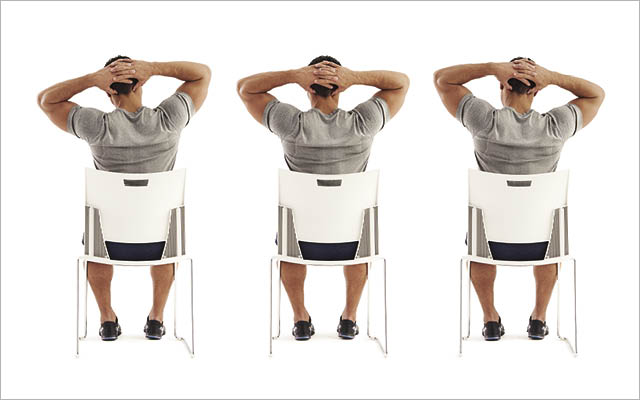You arrive at your job feeling fine. But by mid-afternoon, you’re feeling like someone has put a death grip on your neck and upper back, and no amount of head rolling, neck grasping or shoulder hunching seems to do much good. By the time you get to the gym, your energy is shot and your shoulders don’t feel up to hefting anything heavier than an aspirin bottle.
What gives? Poor posture combined with long hours at a keyboard and monitor can lead to a condition called “computer neck.” The symptoms include pain and tightness in the neck, shoulders and back. That can make working uncomfortable and inefficient and can also mess with your after-work workout plans. Worse, computer neck can degrade into chronic pain – the kind that gets alternately better or worse with stress and overuse but that hardly ever seems to go away.
There is some good news, though. Just rearranging your workspace and performing a few simple, daily exercises can help you ward off neck trouble and keep your entire body healthier in the bargain.
“Neck pain is not an isolated phenomenon,” says Paul Linden, PhD, author of Comfort at Your Computer: Body Awareness Training for Pain-Free Computer Use. “It has to do with how you use your arms, spinal column, pelvis and legs.”
All the more reason to get smart about neck-saving techniques and to get wiser about the role your neck plays in helping you keep it all together.
Know Your Neck
The neck is vulnerable because it plays many roles. Essentially, it’s the body’s utility pole, containing bones, joints, tendons, ligaments, muscles and nerves. It also holds up your head, which weighs in at about 10 pounds – roughly as much as a bowling ball.
Muscles, acting like guide wires, keep the weight of the head centered and supported. Pain most often stems from poor body mechanics that upset this balance and put unnatural strain on the neck.
“As we develop poor posture, over time certain muscles become very tight and shortened and other muscles become lax and lengthened,” says Lynn Millar, PhD, professor of physical therapy at Andrews University in Berrien Springs, Mich. “That process further alters posture, putting the spinal column in a less-than-optimal position.”
Left unchecked, such dysfunction can cause muscle spasms, compression of nerves or a degeneration of the spinal column. Chronic cases bring a litany of problems: stiffness, headaches, work absenteeism, emotional stress and missed workouts. (Try this 15-minute recovery workout, based on moves from the Egoscue Method, to improve your posture).
As more of us rely on computers for work, school and recreation, neck pain has, unfortunately, become quite common. Various experts estimate that it afflicts between one- and two-thirds of all people who use computers. A study published in Occupational and Environmental Medicine interviewed 515 office workers in 2003 and found that one-third of the participants complained of neck pain during the previous year. Complaints were especially prevalent among desk-bound workers with ergonomically poor keyboard placement, high stress and low physical activity. And when the University of California-Berkeley studied 206 graduate students in 2004, it found that at least 60 percent suffered from upper-extremity or neck pain because of computer use.
Even physically fit people are not immune to the problems accrued during a sedentary workday. “The amount of time people spend on sports does not compensate for the eight hours they spend at their desk,” Millar says. “If athletic people have poor body mechanics, they’re still going to have problems.”
Interestingly, problems can arise from either the neck or the torso. When you tilt your head forward to see the computer screen, your trunk compensates to prevent falling over. Conversely, if your back slumps, your neck position becomes distorted.
Eye problems are another notorious cause of improper neck position: When we have to lean too far forward or back to read our screen or reference materials, we put our necks and backs in a bad place.
“It’s like driving on days when the weather is bad,” Millar says. “You try to strain forward with your head to help you see. But then your head angles out from your body like a turtle’s.” Which can leave your upper body feeling about as flexible as a turtle’s shell.
(See “Beyond the Core: How to Flex Your Neck” for two exercises to protect your neck muscles.)
6 Ergonomic Tips for Arranging Your Workspace
Most experts agree that reorganizing your workspace is the first step to dealing with neck pain. A healthy environment, after all, encourages good posture and is the most effective preventive measure. “The simple rule is to adjust the workstation to your body,” says Linden, who is also founder of the Columbus Center for Movement Studies in Ohio. “Never adjust your body to the workstation.”
Here are some tips for properly arranging the items in your workspace:
1. Chair
Set your chair at a height that allows your feet to rest comfortably on the floor or on a footrest (unsupported or dangling feet can reduce circulation and cause back pain). Your knees should be slightly lower than your hips. Your thighs should be parallel to the floor or sloping down (knees toward the floor) very slightly. Always “sit tall” with chest up, chin parallel to the floor and head balanced between your shoulders.
2. Keyboard
Both your keyboard and mouse should rest at a height that allows your forearms to be level with the floor and your elbows to bend approximately 90 degrees. Adjust the height of your chair and armrests to support this position. Note that you may need to use a footrest to relieve chair pressure on the backs of your legs.
3. Monitor
Your screen should rest directly in front of you at, or just below, eye level. Scott Donkin, DC, author of Sitting on the Job: A Practical Survival Guide for People Who Earn Their Livings While Sitting, notes that the neck tends to lean forward whenever the eyes have to look more than 25 degrees below level. “That disturbs the natural S-shape of your spine,” Donkin says. This can trigger a sequence of posture dysfunction, because it diminishes the spine’s role as a natural shock absorber and support structure. Pressure increases on spinal discs, and over the long term, there’s a greater risk of degenerative changes and chronic muscle tension throughout the back and neck.
Avoid setting your computer display to one side of your desk unless you can comfortably orient your entire chair and body in that direction: Having your neck always cranked, even at a slight angle, is likely to create muscle imbalances in your neck, shoulders and back.
4. Books and Papers
When you’re working from printed materials, prop them up at eye level next to your screen. Laying them off to the side forces you to crane your neck repeatedly while typing.
5. Phone Cradling
The phone between your shoulder and neck is a surefire recipe for eventual problems. “You wouldn’t consider walking around with your foot in a bear trap all day long,” Linden says. “Why would you want to compress the spinal column and the cervical vertebrae for hours every day?” A headset is a worthwhile investment.
Also, many people place their phone on the same side as their dominant hand, but Donkin suggests putting it on the other side to keep the writing hand free. That also helps to avoid awkward twisting that can cause pain over the long term and encourages you to make more use of the hand, arm and shoulder you tend to move least.
6. Laptops
They’re great for portability, lousy in terms of ergonomics. “The basic problem with a laptop is you can’t get the keyboard low enough and the monitor high enough,” Linden says. “You’re either scrunching your shoulders or scrunching your neck. If you’re using a laptop for a long period of time, you’re in trouble.”
Linden suggests attaching an external keyboard and mouse and raising a laptop on a platform to bring the screen to eye level when you’re in the office. Better yet, attach an external monitor, too. If you’re traveling and a laptop is all you have, take frequent breaks to avoid neck pain.
Listen to Your Body
Once your workspace is properly arranged, it’s time to start paying attention to the most valuable equipment in this equation – you! If your body isn’t comfortable, or if it fatigues quickly, it’s sending you a message you’d be wise to heed.
By taking just a few basic steps and precautions, you can make some important strides toward encouraging healthy body posture and alignment.
First and foremost, get your body moving every now and then. Periodically rotate and stretch your neck from side to side to avoid staying too long in a fixed position.
Do shoulder rolls, stretch your arms and rotate your torso in both directions. Take a five-minute break every hour to get up and move around.
Finally, remember to breathe! More specifically: Breathe deep. People who remain in fixed positions tend to become shallow breathers. Breathing is your body’s most fundamental, life-giving activity. Taking deep breaths reaffirms good posture, and it gives your body and brain a healthy dose of oxygen, helping you stay mentally and physically alert. All of which help you remain more aware of how and what you are doing – and when you need to take a break.
Beyond the Office
When it comes to preventing neck pain that can undermine your workouts, your activities and posture outside of the office matters, too. Be aware of your posture while driving, eating and watching TV, and take special care about the postures you adopt for sleeping.
If you sleep on your back or your side, make sure your pillow keeps your head aligned with your spine. Avoid sleeping on your stomach: It forces your neck to remain in a twisted position for many hours.
Exercises that target the neck area can prevent neck pain, too. The key is to strengthen muscles in the neck and upper back that are often responsible for postural problems. Many types of exercise will get the job done, including yoga, isometric exercises, lifting weights or resistance training with elastic bands.
Jerome Schofferman, MD, author of What to Do for a Pain in the Neck, recommends a few simple exercises that can be done at home or in the gym (for those exercises, see the “Be Nice to Your Neck” below). “Strong muscles are necessary for good posture,” he writes, “and good posture is necessary for underlying structures to heal.”
In the short term, you can ease neck pain by avoiding painful activity, gently massaging the affected area, and alternating hot and cold therapy. Anti-inflammatory over-the-counter medications may help relieve acute pain, but it’s best to avoid using them as a long-term solution. Rest helps, too, but avoid prolonged inactivity, because weak muscles can degenerate further and exacerbate the problem.
If neck pain persists more than two weeks and you’ve taken steps to alleviate your condition, visit your physician or chiropractor. If you have trouble carrying things, or if you experience numbness, tingling or shooting pain down your shoulder, arm or leg, contact a health professional immediately.
Being kind to your body while you’re at work means your body will be kind to you in your off-hours, including during your fitness pursuits. Good posture, deep breathing and practical self-care in the office, according to Linden, translate into better performance during other everyday activities, including athletic and active pursuits of all kinds.
“The good habits you develop at work will carry over into your sport or athletic endeavors,” he says. “You will find yourself using the same body awareness, balance, relaxation and movement efficiency there, too.”
Be Nice to Your Neck
Jerome Schofferman, MD, author of What to do for a Pain in the Neck recommends doing several simple exercises three or four times a week. They strengthen three key muscle groups: the flexors and extensors (which work together to keep the head balanced and are located in front and back of your neck, respectively), and the interscapular muscles (which provide a platform for the head and neck and are located between your shoulder blades). For a pain-free neck, add these exercises to your workout plan:
- Anterior Isometric Head Lifts (for neck flexors). Lie on a carpeted floor or an exercise mat. Bend your knees with feet flat on the floor, about 6 inches apart. Keep your chin perpendicular to the floor, and raise your head slightly, about one-quarter inch, without bending your neck. Use a stopwatch to determine the maximum time you can hold this position. Hold for half to two-thirds of your maximum time, then rest. Do three sets. When this becomes easy, you can add weight by placing a sock filled with a pound or more of sand or dirt on your forehead.
- Posterior Isometric Head Press (for neck extensors). Lie on a carpeted floor or an exercise mat. Place a quarter-inch cushion or folded towel beneath your head. Press your head into the cushion for 20 seconds, then relax for 30. Do three sets.
- Interscapular Isotonic Strengthening Exercise (for interscapular muscles). Kneel on the floor with your hips bent 90 degrees, chest resting on a bench or stool. Let your arms dangle toward the floor, and hold one-half-pound weights in each hand (a canned food will do). Lift your arms perpendicular to the floor (with elbows bent), squeeze your shoulder blades together, and hold five to 10 seconds. Do three sets of 10. As you gain strength, slowly increase the amount of weight you lift to 1 or 2 pounds.
This article originally appeared as “Pain in the Neck” in the March 2006 issue of Experience Life.





This Post Has 0 Comments